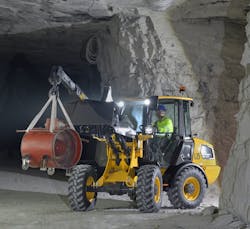Bigger Technology on Smaller Loaders
In recent years, the industry has seen increasing amounts of tech features make their way from larger, production-sized equipment down into smaller equipment.
Though compact wheel loaders (under 200 horsepower) may have been a little behind the pace of the tech additions to CTLs and skid steer loaders due to the latter’s higher volumes, it’s clearly their turn. Here are some of the latest examples.
Transparent bucket
Doosan recently introduced a transparent bucket option for its Dash 7 Series wheel loaders. The option enables operators to activate the technology and make the bucket appear transparent on the in-cab monitor.
“The transparent bucket technology consists of an in-cab monitor and two cameras with protective guarding,” says Aaron Kleingartner, Doosan’s product and dealer marketing manager. “One camera is mounted high, while another camera is mounted low on the front of the machine. The reason for two cameras is because the wheel loader bucket moves up and down.
“When the bucket is low, the view of the second camera is being obstructed,” Kleingartner says. “Similarly, when the bucket is high, the first camera’s view is obstructed. Two cameras ensure each bucket movement is recorded. The system’s processor automatically adjusts the camera inputs into a single image that makes the bucket appear transparent on an in-cab monitor.”
Electrification
Volvo’s L25 Electric compact wheel loader is aimed at customers with low emission requirements, noise regulations, or nighttime working hours, due to its zero exhaust emissions and lower noise levels. “Another benefit—and cost-saving opportunity—is maintenance: Electric machines do not require any engine-related products like oil, oil filters, diesel particulate filters, or DEF,” says Lars Arnold, Volvo CE product manager for electromobility.
“The L25 Electric has an onboard charger that enables it to charge within 6 hours via a 240V outlet,” Arnold says. “In addition, an off-board fast charger can bring the loader to 80 percent power within two hours. Its performance is comparable to or better than its conventional diesel equivalent, with a breakout force of 12,252 lb.-ft. and a fork payload of 4,409 pounds [80 percent].”
Also, Volvo’s Load Assist feature has been extended down into the compact range (models L60 to L90).
Help for operators
“This included operator coaching, which provides real-time guidance to operators for maximum efficiency,” says Chris Connolly, product manager for Volvo’s GPE products. “It also provides proactive tire management to optimize tire life. With real-time information on tire pressure and temperature, the operator can ensure that tires are operating within the correct parameters. If not, they receive an alert and visual display of which tire needs attention. This saves time during machine inspections while also helping to secure the highest levels of tire life, fuel efficiency, machine performance, and operator comfort.”
Somewhat similarly, Doosan’s Dash 7 Series features a smart guidance system. “The system helps wheel loader operators achieve the most fuel-efficient operation possible by analyzing operating habits and providing tips during operation to help improve their productivity,” Kleingartner says. “The LCD monitor in the cab displays a score based on operating habits.”
In touting the Komtrax telematics platform, Komatsu’s product marketing manager Nathan Repp sums up technology’s key benefits: operator familiarity and proper technique.
“Technology features… are important because as operators learn to use the machinery, they develop operation tendencies,” he says. “When machines become more and more integrated, operators become used to these features and expect them to be part of the daily operation. When equipment does not meet the expectation of the operator, the technique will then often reflect that expectation, and the result will be more wear and tear on the machine and components.”
Like other proprietary telematics platforms, Komtrax provides owners with vital information such as fuel consumption, service alerts, performance statistics, and operational data.
